Start » Verticillium in the pistachio tree: a serious disease that you should be aware of to protect your crop.
Verticillium in the pistachio tree: a serious disease that you should be aware of to protect your crop.
Table of Contents
Estimated reading time: 10 minutes
What is the verticillium in the pistachio tree.
Verticillosis or verticillium is caused by fungus Verticillium Dahliae Kleb and It is a fungal disease that affects various plant species, including the pistachio crop. There are different strains of the fungus that vary in their ability to cause disease and their level of virulence. This fungus has the ability to colonize the plant and multiply in the internal tissues., causing different damages that affect the health of the tree and its production.
Is about a genus of pathogenic fungi that develops in the soil and in plant tissues. Verticillium fungi can remain in the soil for long periods, even more than 15 years., which makes them difficult to eradicate and may determine their persistence in pistachio verticillosis infection.
How does the verticillium fungus get to the pistachio tree?
The spores of the verticillium fungus usually reach the pistachio tree through the soil, where they remain dormant until they find the right conditions to germinate in the roots. Thence, spores ascend through the xylem to the branches and leaves, where they begin to develop and spread. Besides, The spread can also be direct through contact with wounds or cuts in the tree or with contaminated machinery and tools..
What symptoms does verticillosis produce in the pistachio tree?
Symptoms of verticillium infection in pistachio They may vary depending on the age of the affected tree and the state of the infection.. At first, the tree may show a retarded growth, leaves may wilt and fall prematurely, and present necrotic spots on the leaves and fruits. In more extreme cases, verticillosis can cause branches and leaves to die and dry out, affecting the production of pistachios in the crop. It is important to be alert to the presence of these symptoms and act quickly to prevent the spread of the disease and minimize damage caused to the tree.
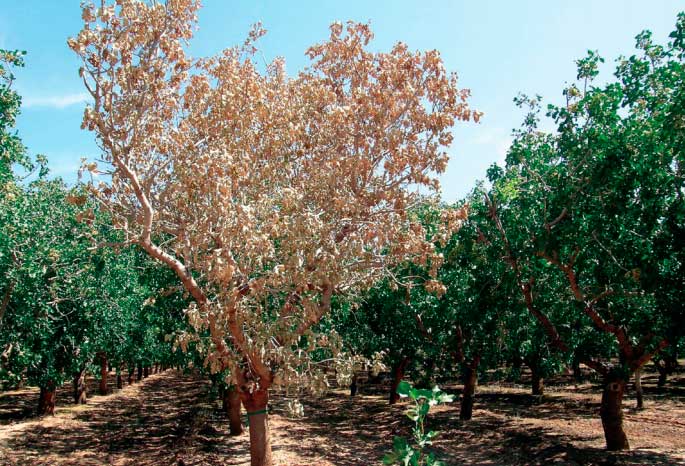
How to prevent verticillium in the pistachio tree.
Preventing and controlling the appearance of verticillosis in the pistachio tree is essential to maintain optimal crop production. Below, we explain the different preventive measures that can be carried out to prevent its appearance.
Soil analysis and selection of resistant varieties.
Before planting the pistachio tree, it is recommended to carry out a soil analysis to know its physical and chemical characteristics and thus choose the type of variety that best adapts to the properties of the soil. Besides, It is important to select pistachio varieties resistant to Verticillium, such as the UCB1 rootstock, always from seed. It is important to highlight that plants on UCB1 cloned in the laboratory are currently being marketed, whose level of resistance to Verticillium remains to be proven in serious and rigorous studies. Worse still, there is currently the sale of a supposed UCB1 that unfortunately does not come from the parental trees of the University of California Davis. We have already verified in the field the weakness of this UCB1 pseudo-pattern, causing discontent or frustration for the farmer.
Preventive measures in the pistachio plantation.
Preventive measures must be carried out before and during the planting of the pistachio tree to avoid the appearance of Verticillium:
- Eliminate any trace of infected plants in the planting area.
- Control irrigation to avoid waterlogging in the soil.
- Use of certified and sterilized plant material to prevent the spread of the disease.
- Manage planting density well.
- Apply a soil treatment with a fungicide before planting the pistachio tree to eliminate possible Verticillium spores.
Crop care.
Caring for the pistachio tree throughout its life is essential to prevent the appearance of Verticillium.. To do this, it is advisable to carry out the following preventive measures:
- Keep the soil at a depth of 25-30 cm free of weeds to prevent this and other diseases from spreading to the crop.
- Control soil moisture levels to avoid excess or shortage of water.
- Carry out selective pruning to eliminate infected or injured branches and, in this way, prevent their spread to the rest of the tree.
- Correctly apply specific fungicide treatments for Verticillium at the right time.
- Carry out periodic monitoring of the plant to detect any type of appearance of disease symptoms.
Preventing the appearance of Verticillium in the pistachio tree is essential to maintain optimal crop production. Carrying out preventive and care measures will prevent the spread of the disease and keep the crop healthy.
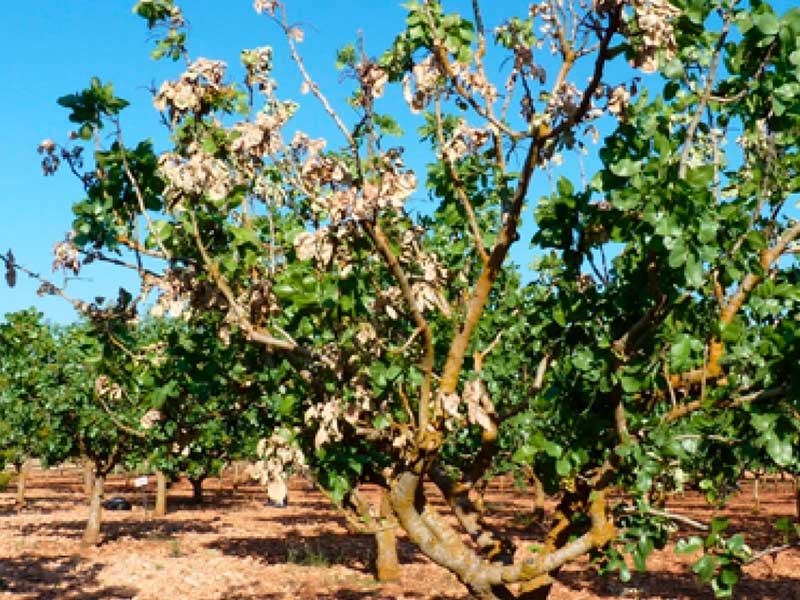
Treatment of verticillium in the pistachio tree.
After identifying and confirming that a pistachio tree is infected by Verticillium, it is important to implement the necessary measures. Proper tillage and treatment can prevent spread and restore crop health.
How to control verticillium in the pistachio tree.
Control of verticillium in the pistachio tree is very important to prevent the spread of the disease. Here are some steps you can take:
- Prune infected branches and leaves to prevent the spread of the fungus. Cut branches should be burned or removed, rather than left on the ground.
- Disinfect tools and machinery after pruning and any other activity that could spread the disease.
- Avoid excessive watering and maintain good ventilation of the tree and its surroundings to avoid excessive humidity and the spread of the fungus.
Ensure proper cleaning and care of the soil around the tree to prevent the spread of the pathogen.
Fungicide treatments against verticillosis.
The application of specific fungicides can be effective in the treatment of Verticillium in the pistachio tree. It is important to highlight that proper and timely application of these products is essential for their effectiveness. In addition, it should be taken into account that frequent application of the same fungicide can increase the resistance of the fungus to said chemical product. Therefore, it is advisable to alternate fungicides to combat the disease.
Measures to prevent its spread.
It is important to mention that The spread of Verticillium can also be reduced by preventive measures. The following tips should be kept in mind:
- Perform soil analysis and choose fungus-resistant rootstocks to plant new pistachio trees.
- Maintain good hygiene of the machinery and work tools used in cultivation.
- Avoid overwatering the soil and ensure good ventilation of the growing area.
- Keep the tree healthy and well nourished so it can better resist disease.
Other diseases of the pistachio tree and their prevention.
In addition to verticillosis, there are other diseases that can affect the pistachio crop, although they are less dramatic than the one mentioned above, since they are easy to treat. In this section we describe some of these diseases, which we have already written about in other entries on our blog, or which we will write about soon, and how to prevent them.
Alternaria and botryosphere in the pistachio tree.
The alternaria and the botryosphere, which we already talked about in this entry, are fungal diseases that cause spots to appear on pistachio fruits. In the case of the botryosphere, these spots become covered with mold, which causes the loss of fruit quality.
To prevent these diseases, in addition to eliminating infected fruits, it is important to carry out good care of the pistachio tree, such as correct pruning, good nutrition and an adequate irrigation system. You must also maintain the hygiene of the plot to prevent the spread of these diseases.
Septoria in the pistachio tree.
Septoria is another fungal disease, which we will talk about in future posts, which manifests itself in the pistachio tree through the appearance of small brown spots on the leaves that can spread to the rest of the tree.
To prevent this disease, it is important to carry out good hygiene on the plot, removing infected branches and leaves and disinfecting tools after use. In addition, it is advisable to follow work and care practices, such as maintaining a good irrigation and tree nutrition system.
Pistachio rust.
Pistachio rust, which we will also talk about in future blog posts, is another fungal disease that manifests itself, in this case, through appearance of reddish spots on the leaves and mummification of the fruits. Besides, can cause branches to die of the plant.
To prevent this disease, it is important to carry out good hygiene of the plot and tools, as well as the use of specific fungicides. It is also necessary to maintain a good irrigation and nutrition system for the tree.
- Use resistant rootstocks, such as UCB1 that you can buy in our Online store in forest tray or in pots .
- Do soil analysis prior to planting.
- Carry out selective pruning.
- Maintain adequate hygiene in tools and machinery.
- Remove infected branches and leaves.
How to keep the pistachio tree healthy.
Finally, and to conclude this entry on our blog, we are going to give you some practical advice to maintain the health of your pistachio tree crops. Keeping diseases and pests at bay, which could otherwise affect the profitability of your pistachio plantation.
Good tillage practices.
To keep the pistachio tree healthy, it is essential to carry out proper tillage practices. First of all, it is important to make a selective pruning to eliminate branches and leaves infected by diseases such as Verticillium in the pistachio tree, as well as avoid planting other trees and shrubs in the vicinity that could transmit the disease. In addition, It is important to avoid overwatering and ensure the soil has adequate drainage., to prevent the appearance of fungal diseases. Another recommended practice is the removal of remains from the previous harvest and Cleaning and disinfecting tools, machinery and equipment used in the cultivation of pistachio, to prevent the spread of diseases.
Tips to prevent pistachio diseases.
In addition to tillage practices, there are a series of tips that can help prevent diseases in pistachio cultivation. First of all, It is important to choose varieties resistant to diseases such as Verticillium in the pistachio tree., such as those from UCB1 certified seeds by UC Davis, which are very resistant to verticillosis, and perform a soil analysis prior to planting to identify possible pH, nutrient and pathogen problems that could cause verticillosis. In addition, It is essential to carry out an adequate soil fertilization and ensuring that plants have access to the nutrients and minerals necessary to grow healthy and strong.
Also It is important to maintain correct irrigation, avoiding both excess and deficit of water, to avoid the appearance of diseases and pests in the crop. Another useful tip is the use of biological control techniques, such as the introduction of predatory insects and the use of plant extracts and other organic compounds to prevent the development of pathogens in pistachio cultivation.
Caring for the pistachio tree during the summer.
Finally, now that summer has just begun, it is important to pay special attention to the care of the pistachio tree to prevent the appearance of diseases and pests. Correct watering, with an adequate depth and frequency determined by weather conditions, is essential to keep the plant in optimal condition. Another fundamental care is the carrying out preventive treatments with specific phytosanitary products against diseases and pests of the pistachio tree, especially in those towns or regions where Verticillium in the pistachio tree is already present.
Sources:
- PISTACHI TREE DISEASES and other alterations caused by abiotic agents. “EL CHAPARRILLO” AGRO-ENVIRONMENTAL RESEARCH CENTER.
- UC IPM Pest Management Guidelines: Pistachio UC ANR Publication 3461.
- Most common pistachio disease and pests. eOrchad blog.
Specialized technical advisory services
At Mister Pistacho we offer specialized technical advisory services for pistachio producers, in order to offer personalized and effective solutions in the control of the Botryosphere and other diseases and pests of the crop. These services have specialized professionals who provide information on the proper management of the crop and the measures to take to prevent and control the disease.
If you need help with verticillosis or any other fungal disease of the pistachio tree, do not hesitate to contact us.
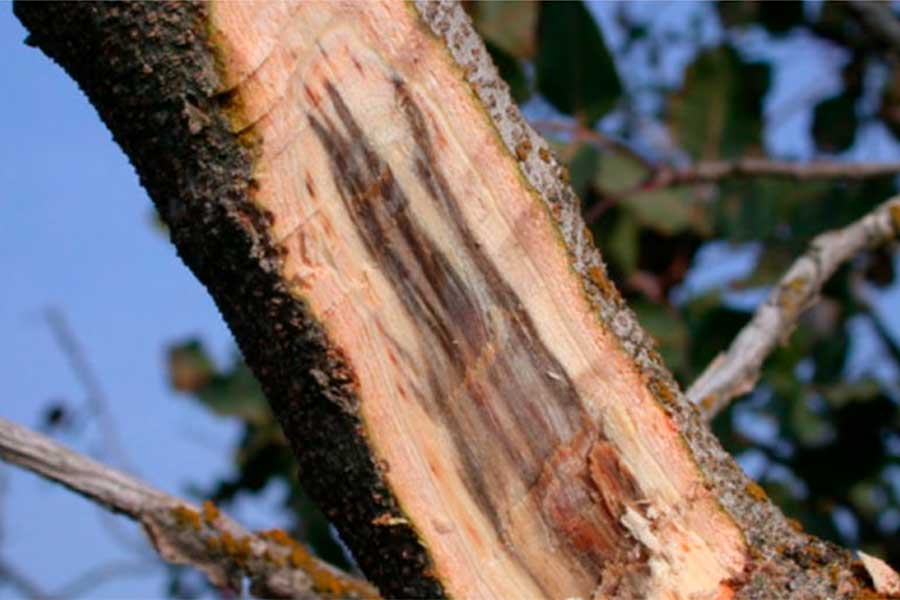
Related content:
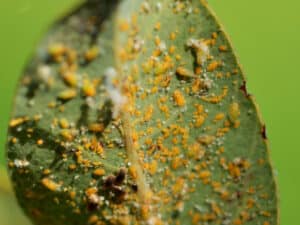
Pistachio psylla: A threatening pest in crops in Castilla-La Mancha and Extremadura
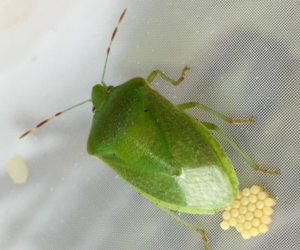
Pests of the pistachio tree: The green stink bug (Nezara viridula L.)
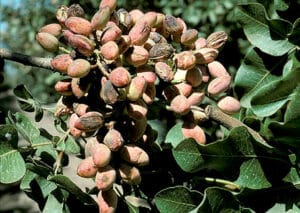
Alternaria in the pistachio tree: how to prevent and treat this common disease.
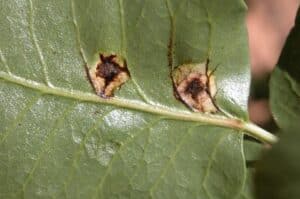
Rust in the pistachio tree: Pileolaria terebinthi C. and its impact
Seeker:
Find out now:
You may also like:
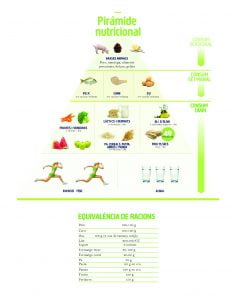
Pistachios star in the new pyramid of the Mediterranean Diet, one of the healthiest in the world.
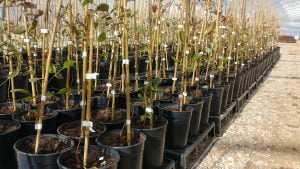

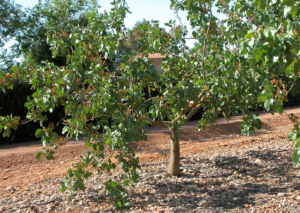
Pruning the pistachio tree: a key aspect in the cultivation and growth of the plant.
Entries by category:
Share this post with one click:
